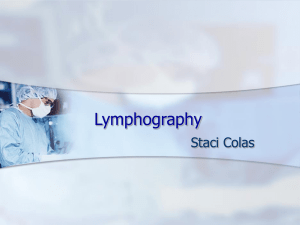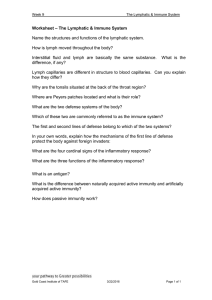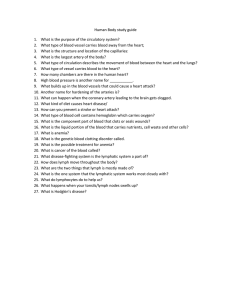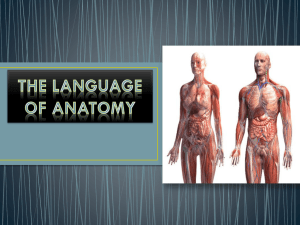Digestion 2 The Story Continues 1
advertisement
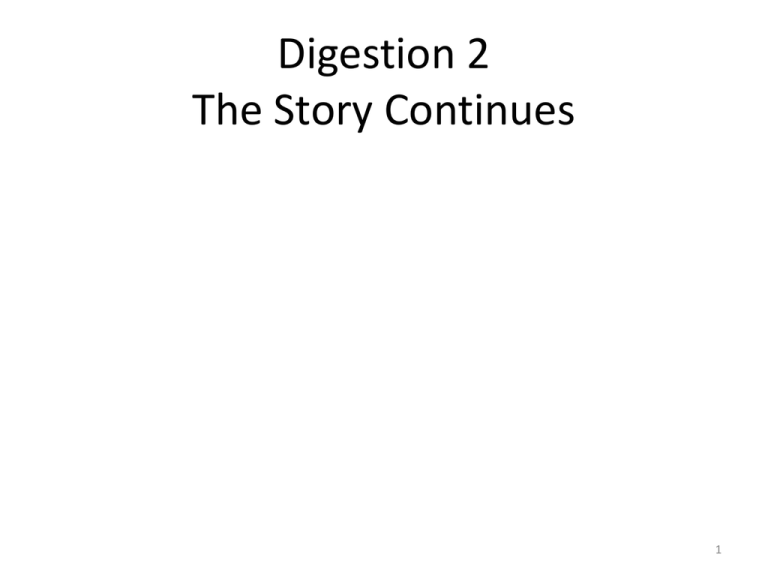
Digestion 2 The Story Continues 1 Fat Digestion Fats are of course water insoluble and as a result they are treated differently from the digestion of carbohydrates and proteins. Whereas most digestive products enter the blood stream, fats enter the lymph system. http://mek1980.wordpress.com/2008/06/ 2 Lymphatic System The lymphatic system is a complex network of lymph nodes, lymph ducts, lymph capillaries and lymph vessels that produce and transport lymph from tissues to the circulatory system. Lymph is blood plasma. http://lumologie.com.au/Page/TheLymphaticSystem 3 Lymphatic System Lymph leaks from the capillaries of the circulatory system, becoming interstitial fluid, and filling the space between individual cells of tissue. The excess interstitial fluid is collected by the lymphatic system into lymph capillaries. http://lumologie.com.au/Page/TheLymphaticSystem 4 Lymph Nodes Lymph nodes are small bean-shaped structures that are usually less than 2.5 cm in length. They are widely distributed throughout the body along the lymphatic pathways where they filter the lymph before it is returned to the blood. They tend to concentrate in regions such as the groin, armpits and neck. Lymph nodes contain high concentration of lymphocytes. http://training.seer.cancer.gov/module_anatomy/unit8_2_lymph_compo.html 5 Lymphatic System Finally, unlike the blood system which has a heart, the lymphatic system has no centralized pump. Instead movement is mediated by muscle contraction along the lymph vessels and one-way valves. http://lumologie.com.au/Page/TheLymphaticSystem 6 Lymphatic System: lymphatic filariasis (Elephantiasis) Caused by Parasitic nematodes blocking the lymphatic system and preventing drainage of lymph back to the main circulatory system. Transmitted by certain Mosquito species. http://www.bio.davidson.edu/Courses/immunology/Students/spring2006/Heeren 7 Lymphatic System http://trc.ucdavis.edu/biosci10v/bis10v 8 Lymph System: Drains into Subclavian Veins http://www.iupucanatomy.com/chapter_23.htm 9 Other Related Organs Spleen: Destroys redundant red blood cells and in some animals it also stores blood (horses and dogs). Also involved in filtering blood, in a sense in acts as a large lymph node but is not connected to the main lymph system. http://trc.ucdavis.edu/biosci10v/bis10v 10 Other Related Organs Thymus: Maturing lymphocytes – T Cells. Not used significantly in adults, mainly an organ of childhood and in fact diminishes in size with age. Can be bought at good butchers, where it is called sweatbread. http://trc.ucdavis.edu/biosci10v/bis10v 11 Other Related Organs Tonsils: Lymphatic tissue that is used to combat respiratory infections especially in childhood. http://trc.ucdavis.edu/biosci10v/bis10v 12 Other Related Organs Tonsils: Lymphatic tissue that is used to combat respiratory infections especially in childhood. Often a troublesome organ due to it sensitivity to infection. Most infections (Tonsillitis) are probably viral but sometimes opportunistic bacteria such as streptococcus or even yeast can cause further problems. Tonsillitis can abscess if not looked after to form a quinsy which can be removed by surgical incision and drainage of the pus. http://en.wikipedia.org/wiki/Image:Tonsillitis.jpg 13 14 Figure 21-19 - Overview Summary of Lipid Digestion 15 Lymph System: Summary of Functions 1.Drains excess lymph back to blood system. 2.Filters out particles, bacteria and some proteins 3.Transports fatty acids and Cholesterol http://www.iupucanatomy.com/chapter_23.htm 16 Large Intestine 17 Large Intestine The large intestine is separated from the small intestine by the ileocecal value. The large intestine comprises of two sections: a) Cecum (large pouch , storage?, varies in size according to animal) b) Colon c) Appendix? (Probably a vestigial structure , or storage for flora ) 18 Appendix Probably a vestigial structure from a time when we consumed more plant material. Rabbit Digestive Tract http://www.fao.org/docrep/x5082e/x5082E05.htm 19 20 Large Intestine 1. About 1.5 m long 2. Smooth surface but has goblet cells. 3. Absorbs water, electrolytes and some vitamins 4. Some breakdown of food by bacteria can be also be absorbed here (eg Vitamin K, Biotin). 21 Last but not Least Anus: Comprises of two values (or sphincters): 1. Inner: Smooth Muscle (involuntary) 2. Outer: Skeletal Muscle (voluntary) Composition of Feces: 1/4: Dry Matter 1/5: Bacteria The rest is water. Odor is from H2S and other sulfur compounds such as mercaptans (organic S) 22 Other Kinds of Digestion Ruminant Digestion 23 Four Stomachs http://www.dkimages.com/discover/DKIMAGES/Discover/Home/Animals/Mammals/Even-toed-HoofedMammals/Anatomy/Internal-Anatomy/Internal-Anatomy-1.html 24 Four Stomachs http://www.nicksnowden.net/Module_3_pages/The_Cow_as_a_Herbivore_and_mutualist.htm 25 Four Stomachs The Rumen contains a complex mixture of bacteria and protozoa, these organism digest cellulose into organic acids. http://www.scienceimage.csiro.au/index.c fm?event=site.image.detail&id=2181 http://www.admani.com/AllianceBeef/Technic alEdge/Ruminant%20Feed%20Microbes.htm Cows "chew the cud" i.e. they chew food for long periods, swallow it, regurgitate it and then chew it again. http://www.nicksnowden.net/Module_3_pages/The_Cow_as_a_Herbivore_and_mutualist.htm 26 Four Stomachs cellulose -> glucose -> ethanoic acid + carbon dioxide + methane http://www.nicksnowden.net/Module_3_pages/The_Cow_as_a_Herbivore_and_mutualist.htm 27

